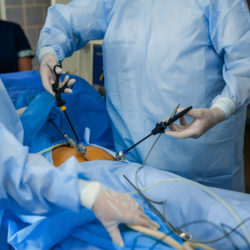Top Class Actions’s website and social media posts use affiliate links. If you make a purchase using such links, we may receive a commission, but it will not result in any additional charges to you. Please review our Affiliate Link Disclosure for more information.

A power morcellator is a surgical device that a surgeon uses to cut up larger pieces of tissue into smaller ones so that the offending tissue may be easily removed.
Laparoscopic hysterectomies (removal of the uterus) and myomectomies (removal of fibroids) are common procedures during which a power morcellator may be used.
The power morcellator looks like a drill with sharp blades on the end. Doctors insert the end of the device into small incisions in the abdomen. The morcellator then chops up the tissue, which is then vacuumed from the body.
The benefits linked to procedures like this are that the surgery requires much less recovery time and the post-operative wound is much smaller. This means there is less of a chance of infection or wound complications.
Even though power morcellator devices have been said to be more efficient, there have been life-threatening problems associated with the device that women should take under consideration when making choices about their own care.
Cancer Caused by Morcellation
When a surgeon uses a power morcellator in a procedure such as a hysterectomy, it has been found that women have an increased risk of cancer aggravation caused by morcellation.
If a woman has undetected uterine sarcoma, when the power morcellator device ruptures the uterine wall, those cancer cells may be released into the woman’s body.
Cancer cells that may not have spread were it not for the morcellation device may develop into a much more aggressive and fatal type of cancer.
The spreading of cancer caused by morcellation is a real risk because it is impossible to reliably determine if a woman has uterine sarcoma before an invasive procedure. When the power morcellator disrupts the tissue in the uterine wall, cancer cells, if present, can spread throughout the whole abdominal cavity.
Undisrupted, while the cancer cells would still have been present were it not for the morcellation procedure, the cancer would likely not have spread and progressed at the same rate. When the cells are spread, aggressive cancer caused by morcellation is a real possibility.
Experts estimate that one in 350 women who undergo a uterine fibroid surgery using this device may have undiagnosed sarcoma and are at risk of developing leiomyosarcoma.
Leiomyosarcoma is a type of soft tissue sarcoma that can develop in the soft tissues of the body such as the muscle, fat, blood vessels and the tissues that support and protect the body’s organs.
Power morcellation lawsuits may involve the following procedures:
- Myomectomy (removal of fibroids)
- Hysterectomy (removal of the uterus)
- Oophorectomy (removal of the ovaries)
- Salpingectomy (removal of fallopian tubes)
If you suspect you might have developed cancer caused by morcellation, you may be eligible for financial compensation. An experienced attorney is waiting to help you with your claim.
Do YOU have a legal claim? Fill out the form on this page now for a free, immediate, and confidential case evaluation. The morcellation cancer attorneys who work with Top Class Actions will contact you if you qualify to let you know if an individual lawsuit or class action lawsuit is best for you. [In general, morcellator cancer lawsuits are filed individually by each plaintiff and are not class actions.] Hurry — statutes of limitations may apply.
ATTORNEY ADVERTISING
Top Class Actions is a Proud Member of the American Bar Association
LEGAL INFORMATION IS NOT LEGAL ADVICE
Top Class Actions Legal Statement
©2008 – 2024 Top Class Actions® LLC
Various Trademarks held by their respective owners
This website is not intended for viewing or usage by European Union citizens.
Get Help – It’s Free
Join a Free Morcellation Cancer Class Action Lawsuit Investigation
If you or a loved one were diagnosed with cancer in the uterus, pelvis or abdomen within two years of undergoing surgery for a myomectomy (removal of fibroids), hysterectomy (removal of the uterus), oophorectomy (removal of the ovaries), or salpingectomy (removal of fallopian tubes), you may have a legal claim. See if you qualify by filling out the short form below.
An attorney will contact you if you qualify to discuss the details of your potential case at no charge to you.
Please Note: If you want to participate in this investigation, it is imperative that you reply to the law firm if they call or email you. Failing to do so may result in you not getting signed up as a client, if you qualify, or getting you dropped as a client.
Oops! We could not locate your form.












